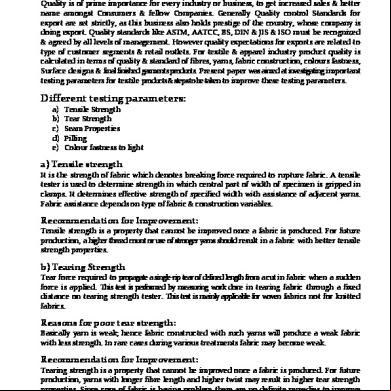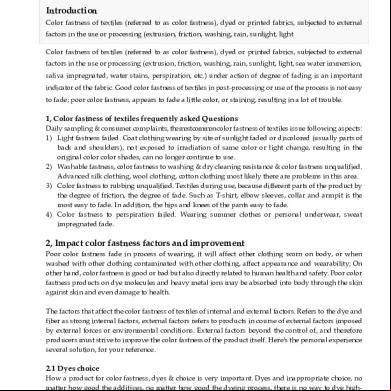This document was ed by and they confirmed that they have the permission to share it. If you are author or own the copyright of this book, please report to us by using this report form. Report 2z6p3t
Overview 5o1f4z
& View Operations & Productivity-practice Problems as PDF for free.
More details 6z3438
- Words: 727
- Pages: 3
Operations & productivity-Practice problems Problem 1: Mance Fraily, the Production Manager at Ralts Mills, can currently expect his operation to produce 1000 square yards of fabric for each ton of raw cotton. Each ton of raw cotton requires 5 labor hours to process. He believes that he can buy a better quality raw cotton, which will enable him to produce 1200 square yards per ton of raw cotton with the same labor hours. What will be the impact on productivity (measured in square yards per labor-hour) if he purchases the higher quality raw cotton? Problem 2: C. A. Ratchet, the local auto mechanic, finds that it usually takes him 2 hours to diagnose and fix a typical problem. What is his daily productivity (assume an 8 hour day)? Mr. Ratchet believes he can purchase a small computer trouble-shooting device, which will allow him to find and fix a problem in the incredible (at least to his customers!) time of 1 hour. He will, however, have to spend an extra hour each morning adjusting the computerized diagnostic device. What will be the impact on his productivity if he purchases the device? Problem 3: Joanna French is currently working a total of 12 hours per day to produce 240 dolls. She thinks that by changing the paint used for the facial features and fingernails that she can increase her rate to 360 dolls per day. Total material cost for each doll is approximately $3.50; she has to invest $20 in necessary supplies (expendables) per day; energy costs are assumed to be only $4.00 per day; and she thinks she should be making $10 per hour for her time. Viewing this from a total (multifactor) productivity perspective, what is her productivity at present and with the new paint? Problem 4: How would total (multifactor) productivity change if using the new paint raised Ms. French’s material costs by $0.50 per doll? Problem 5: If she uses the new paint, by what amount could Ms. French’s material costs increase without reducing total (multifactor) productivity?
ANSWERS: 1
Problem 1: Current labor productivity =
New labor productivity =
1000 sq yds 200 sq yds per hour 1 ton*5 hours
1200 sq yds 240 sq yds per hour 1 ton * 5 hours
Productivity improves 20% = ( 240 - 200 ) / 200 = .2 Problem 2:
Current productivity =
8 hours per day 4 problems per day 2 hours per problem
Productivity with computer =
7 hours per day 7 problems per day 1 hour per problem
74 3 Productivity improves 75% .75 4 4 Problem 3: Currently
Using the new paint
Labor
12 hrs * $10
= $120
12 hrs * $10
= $ 120
Material
240 * $3.50
= $840
360 * $3.50
= $1260
Supplies
= $ 20
=$
20
Energy
=$
=$
4
Total Inputs
= $984
Productivity
240/984
4
= 0.24
= $1404 360/1404
Problem 4: If the material costs increase by $0.50 per doll: Using the new paint Labor
12 hrs * $10
2
= $ 120
= .26
Material
360 * $4.00
= $1440
Supplies
=$
20
Energy
=$
4
Total Inputs
= $1584
Productivity
360/1584
= 0.23
Problem 5: From the answer to Problem 3 we know the following: Currently
Using the new paint
Labor
12 hrs * $10
= $120
12 hrs * $10
= $ 120
Material
240 * $3.50
= $840
360 * $3.50
= $1260
Supplies
= $ 20
=$
20
Energy
=$ 4
=$
4
Total Inputs
= $984
= $1404
Productivity
240/984
= 0.24
360/1404
= .26
We want to know how high material cost could go, using the new paint, before the productivity drops to the current level of 0.24. In mathematical we make the material cost a variable (X), set the new multifactor productivity value to the current level, 0.24, and solve for X. 360/(($12x10) + 360 $(X) + $20 + $4) = 0.24 360 = 0.24($120 + 360$(X) + $20 + $4) 360 = $28.8 + 86.4$(X) + $4.8 + $.96 325.44 = 86.4$(X) $(X)= 325.44/86.4 = $3.7666 $3.77 It follows then that the new paint could raise Materials cost by no more than approximately $0.27 (the difference between $3.77 and $3.50) before Ms. French would experience a decrease in multifactor productivity.
3
ANSWERS: 1
Problem 1: Current labor productivity =
New labor productivity =
1000 sq yds 200 sq yds per hour 1 ton*5 hours
1200 sq yds 240 sq yds per hour 1 ton * 5 hours
Productivity improves 20% = ( 240 - 200 ) / 200 = .2 Problem 2:
Current productivity =
8 hours per day 4 problems per day 2 hours per problem
Productivity with computer =
7 hours per day 7 problems per day 1 hour per problem
74 3 Productivity improves 75% .75 4 4 Problem 3: Currently
Using the new paint
Labor
12 hrs * $10
= $120
12 hrs * $10
= $ 120
Material
240 * $3.50
= $840
360 * $3.50
= $1260
Supplies
= $ 20
=$
20
Energy
=$
=$
4
Total Inputs
= $984
Productivity
240/984
4
= 0.24
= $1404 360/1404
Problem 4: If the material costs increase by $0.50 per doll: Using the new paint Labor
12 hrs * $10
2
= $ 120
= .26
Material
360 * $4.00
= $1440
Supplies
=$
20
Energy
=$
4
Total Inputs
= $1584
Productivity
360/1584
= 0.23
Problem 5: From the answer to Problem 3 we know the following: Currently
Using the new paint
Labor
12 hrs * $10
= $120
12 hrs * $10
= $ 120
Material
240 * $3.50
= $840
360 * $3.50
= $1260
Supplies
= $ 20
=$
20
Energy
=$ 4
=$
4
Total Inputs
= $984
= $1404
Productivity
240/984
= 0.24
360/1404
= .26
We want to know how high material cost could go, using the new paint, before the productivity drops to the current level of 0.24. In mathematical we make the material cost a variable (X), set the new multifactor productivity value to the current level, 0.24, and solve for X. 360/(($12x10) + 360 $(X) + $20 + $4) = 0.24 360 = 0.24($120 + 360$(X) + $20 + $4) 360 = $28.8 + 86.4$(X) + $4.8 + $.96 325.44 = 86.4$(X) $(X)= 325.44/86.4 = $3.7666 $3.77 It follows then that the new paint could raise Materials cost by no more than approximately $0.27 (the difference between $3.77 and $3.50) before Ms. French would experience a decrease in multifactor productivity.
3










